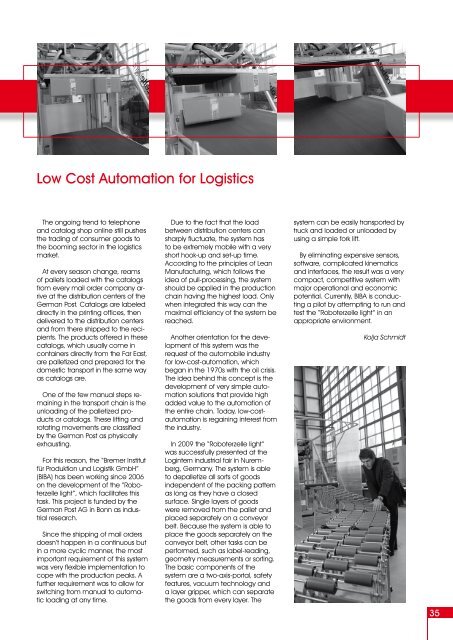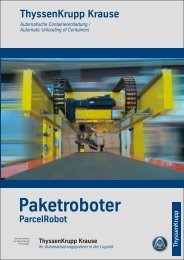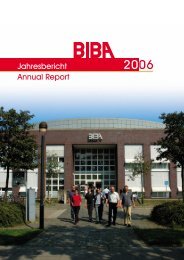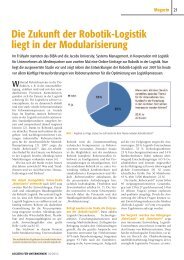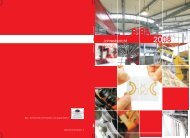Jahresbericht 2009 - Biba - Universität Bremen
Jahresbericht 2009 - Biba - Universität Bremen
Jahresbericht 2009 - Biba - Universität Bremen
Sie wollen auch ein ePaper? Erhöhen Sie die Reichweite Ihrer Titel.
YUMPU macht aus Druck-PDFs automatisch weboptimierte ePaper, die Google liebt.
Low Cost Automation for LogisticsThe ongoing trend to telephoneand catalog shop online still pushesthe trading of consumer goods tothe booming sector in the logisticsmarket.At every season change, reamsof pallets loaded with the catalogsfrom every mail order company arriveat the distribution centers of theGerman Post. Catalogs are labeleddirectly in the printing offices, thendelivered to the distribution centersand from there shipped to the recipients.The products offered in thesecatalogs, which usually come incontainers directly from the Far East,are palletized and prepared for thedomestic transport in the same wayas catalogs are.One of the few manual steps remainingin the transport chain is theunloading of the palletized productsor catalogs. These lifting androtating movements are classifiedby the German Post as physicallyexhausting.For this reason, the “Bremer Institutfür Produktion und Logistik GmbH”(BIBA) has been working since 2006on the development of the “Roboterzellelight”, which facilitates thistask. This project is funded by theGerman Post AG in Bonn as industrialresearch.Since the shipping of mail ordersdoesn’t happen in a continuous butin a more cyclic manner, the mostimportant requirement of this systemwas very flexible implementation tocope with the production peaks. Afurther requirement was to allow forswitching from manual to automaticloading at any time.Due to the fact that the loadbetween distribution centers cansharply fluctuate, the system hasto be extremely mobile with a veryshort hook-up and set-up time.According to the principles of LeanManufacturing, which follows theidea of pull-processing, the systemshould be applied in the productionchain having the highest load. Onlywhen integrated this way can themaximal efficiency of the system bereached.Another orientation for the developmentof this system was therequest of the automobile industryfor low-cost-automation, whichbegan in the 1970s with the oil crisis.The idea behind this concept is thedevelopment of very simple automationsolutions that provide highadded value to the automation ofthe entire chain. Today, low-costautomationis regaining interest fromthe industry.In <strong>2009</strong> the “Roboterzelle light”was successfully presented at theLogintern industrial fair in Nuremberg,Germany. The system is ableto depalletize all sorts of goodsindependent of the packing patternas long as they have a closedsurface. Single layers of goodswere removed from the pallet andplaced separately on a conveyorbelt. Because the system is able toplace the goods separately on theconveyor belt, other tasks can beperformed, such as label-reading,geometry measurements or sorting.The basic components of thesystem are a two-axis-portal, safetyfeatures, vacuum technology anda layer gripper, which can separatethe goods from every layer. Thesystem can be easily transported bytruck and loaded or unloaded byusing a simple fork lift.By eliminating expensive sensors,software, complicated kinematicsand interfaces, the result was a verycompact, competitive system withmajor operational and economicpotential. Currently, BIBA is conductinga pilot by attempting to run andtest the “Roboterzelle light” in anappropriate environment.Kolja Schmidt35


